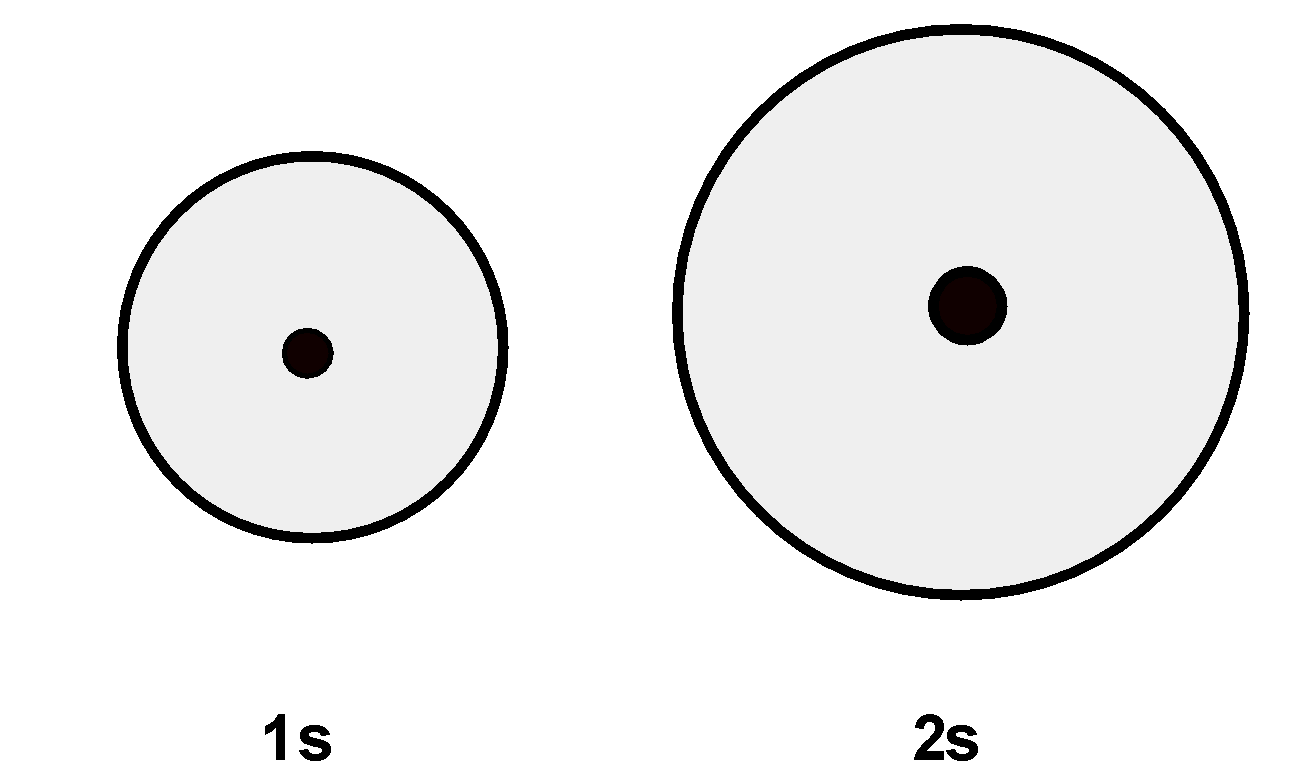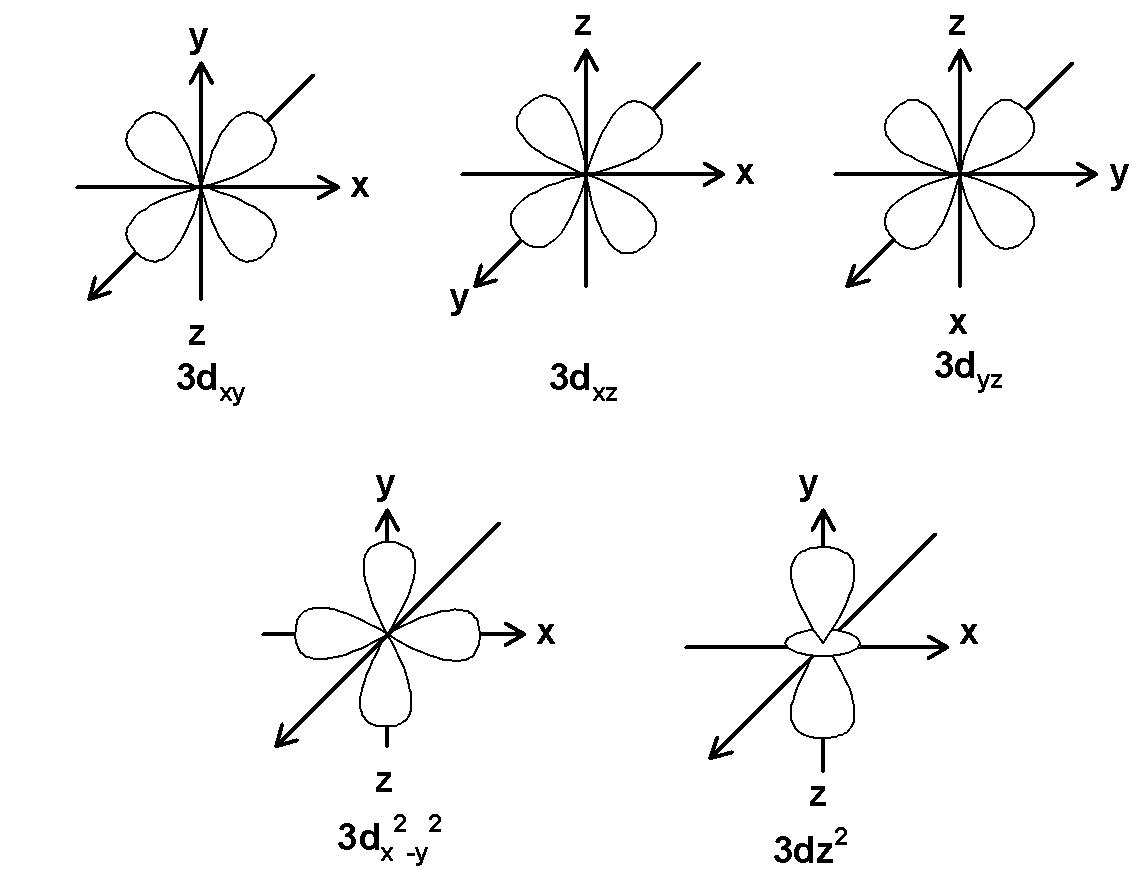
What is an orbital? Draw the shapes of the 1s, 2s, $\text{ 2}{{\text{p}}_{\text{x}}}\text{ }$ , $\text{ 2}{{\text{p}}_{\text{y}}}\text{ }$,$\text{ 2}{{\text{p}}_{\text{z}}}\text{ }$, $\text{ 3}{{\text{d}}_{\text{xy}}}\text{ }$ , $\text{ 3}{{\text{d}}_{\text{yz}}}\text{ }$, $\text{ 3}{{\text{d}}_{\text{xz }}}\text{ }$,$\text{ 3}{{\text{d}}_{{{\text{x}}^{\text{2}}}-{{\text{y}}^{\text{2}}}}}\text{ }$and $\text{ 3}{{\text{d}}_{{{z}^{2}}}}\text{ }$orbitals.
Answer
554.7k+ views
Hint: Orbitals are the regions in the atom in which electrons are more likely to be found. Three are four different types of orbitals. These are s, p , d , and f .s is a spherical orbital, p is a dumbbell-shaped orbital, d are a double dumbbell-shaped orbital and f orbitals have a more complex structure.
Complete Solution :
An orbital is a three-dimensional representation of a region in which the electrons are more likely to be found around the atom.in atomic orbitals, the orbital is the mathematical function that describes the location of an electron in the atom. Each orbital of an atom has a unique set of three quantum numbers which are principal quantum number(n), azimuthal quantum number (l), and magnetic quantum number (m) .this orbitals have a characteristic shape. This is as follows:
1) s-orbital:
It is a completely spherical and symmetrical orbital. These orbitals are closest to the nucleus.as the principal quantum number increases these orbitals get bigger. The order of the s-orbitals is as follows,
$\text{ 1s }<\text{ 2s }<\text{ 3s }<\text{ 4s }$
S orbitals do not have a node. The s orbital is as shown below,

The 1 s and 2s orbital are drawn as follows,

2) p-orbital:
It is a dumbbell-shaped orbital. p orbitals have a node. The p orbitals can occupy six electrons as there are a total of three p orbitals. This three p orbitals are mutually perpendicular to each other and aligned towards the three axes x, y and these three p-orbitals are shown below,

3) d-orbital:
d orbital is double dumbbell-shaped orbitals. This has a cloverleaf shape in the plane. ‘d’ orbitals have an azimuthal quantum number equal to 2 and the minimum quantum number for d-orbitals are 3.the value for the ‘l’ can range from $\text{ }-2\text{ , }-1\text{ , 0 , +1 , +2 }$ . Thus there are a total of five d-orbitals. These 5 d orbitals are designated as $\text{ }{{\text{d}}_{\text{xy}}}\text{ }$ , $\text{ }{{\text{d}}_{\text{yz}}}\text{ }$, $\text{ }{{\text{d}}_{\text{xz }}}\text{ }$,$\text{ }{{\text{d}}_{{{\text{x}}^{\text{2}}}-{{\text{y}}^{\text{2}}}}}\text{ }$ and $\text{ }{{\text{d}}_{{{z}^{2}}}}\text{ }$. The five orbitals for principal quantum number 3 are as shown below,

Note: Note that, orbitals show the probability of finding an electron in an atom. There are 4 orbitals and their names as s stand for sharp, p for principle, d for diffuse, and f for fundamental. S orbital shield nucleus well but p, d, or f orbitals have a diffused shape thus shields the nucleus poorly.
Complete Solution :
An orbital is a three-dimensional representation of a region in which the electrons are more likely to be found around the atom.in atomic orbitals, the orbital is the mathematical function that describes the location of an electron in the atom. Each orbital of an atom has a unique set of three quantum numbers which are principal quantum number(n), azimuthal quantum number (l), and magnetic quantum number (m) .this orbitals have a characteristic shape. This is as follows:
1) s-orbital:
It is a completely spherical and symmetrical orbital. These orbitals are closest to the nucleus.as the principal quantum number increases these orbitals get bigger. The order of the s-orbitals is as follows,
$\text{ 1s }<\text{ 2s }<\text{ 3s }<\text{ 4s }$
S orbitals do not have a node. The s orbital is as shown below,

The 1 s and 2s orbital are drawn as follows,

2) p-orbital:
It is a dumbbell-shaped orbital. p orbitals have a node. The p orbitals can occupy six electrons as there are a total of three p orbitals. This three p orbitals are mutually perpendicular to each other and aligned towards the three axes x, y and these three p-orbitals are shown below,

3) d-orbital:
d orbital is double dumbbell-shaped orbitals. This has a cloverleaf shape in the plane. ‘d’ orbitals have an azimuthal quantum number equal to 2 and the minimum quantum number for d-orbitals are 3.the value for the ‘l’ can range from $\text{ }-2\text{ , }-1\text{ , 0 , +1 , +2 }$ . Thus there are a total of five d-orbitals. These 5 d orbitals are designated as $\text{ }{{\text{d}}_{\text{xy}}}\text{ }$ , $\text{ }{{\text{d}}_{\text{yz}}}\text{ }$, $\text{ }{{\text{d}}_{\text{xz }}}\text{ }$,$\text{ }{{\text{d}}_{{{\text{x}}^{\text{2}}}-{{\text{y}}^{\text{2}}}}}\text{ }$ and $\text{ }{{\text{d}}_{{{z}^{2}}}}\text{ }$. The five orbitals for principal quantum number 3 are as shown below,

Note: Note that, orbitals show the probability of finding an electron in an atom. There are 4 orbitals and their names as s stand for sharp, p for principle, d for diffuse, and f for fundamental. S orbital shield nucleus well but p, d, or f orbitals have a diffused shape thus shields the nucleus poorly.
Recently Updated Pages
Master Class 11 Social Science: Engaging Questions & Answers for Success

Master Class 11 Physics: Engaging Questions & Answers for Success

Master Class 11 Maths: Engaging Questions & Answers for Success

Master Class 11 Economics: Engaging Questions & Answers for Success

Master Class 11 Computer Science: Engaging Questions & Answers for Success

Master Class 11 Chemistry: Engaging Questions & Answers for Success

Trending doubts
What is meant by exothermic and endothermic reactions class 11 chemistry CBSE

10 examples of friction in our daily life

Difference Between Prokaryotic Cells and Eukaryotic Cells

1 Quintal is equal to a 110 kg b 10 kg c 100kg d 1000 class 11 physics CBSE

One Metric ton is equal to kg A 10000 B 1000 C 100 class 11 physics CBSE

Draw a diagram of nephron and explain its structur class 11 biology CBSE




